#the more you become subject to the rules of fiction and thus narrative fate
Text
always a fun time when real life people are doomed by their own narratives. like guys you know it doesn’t have to be like this right? this isn’t a stageplay the foreshadowing isn’t real until you make it real
#what do roman senators rock stars and real pirates have in common#i would love to write a magical realism psychological horror movie about a up-and-coming celebrity#in which the premise is that the more and more you garner a parasocial following#(i.e.#the more and more you are treated like a character instead of a real person)#the more you become subject to the rules of fiction and thus narrative fate#and the protagonist slowly but surely realizes that by becoming famous they’ve sold away their own ontology#//#this happened to my buddy roger waters#god. i need to find that sexy quote from pete townshend about how the music industry is perpetuated on human sacrifice
318 notes
·
View notes
Text
Three Heads has the Dragon... (part 2)
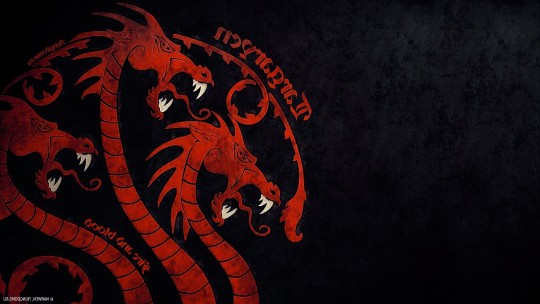
This is the continuation of a previous post that scrutinizes the prophecy of the Three Heads of the Dragon. It is a prophecy that we know very little about, apart from Daenerys’ vision in the House of the Undying and Maester Aemon mentioning it when he’s dying. We do know that it is connected to the prophecy of the Prince that was Promised and that both Rhaegar Targaryen and Maester Aemon believed in it.
My reason for trying to tackle this very ambiguous notion of the Three Heads of the Dragon is that it is a prophecy where fandom speculation has hardened into a kind of orthodoxy where it is believed that the Three Heads mean three dragonriders and possibly three Targaryens - and the theory has devolved into a rather boring guessing game.
The reason that this particular interpretation holds sway is that it is an idea that is introduced in the text itself. However, it is Daenerys’ interpretation and as readers we should be wary when a character thinks that they have cracked the code of a prophecy - we know this in regard to Melisandre who believes that Stannis Baratheon is Azor Ahai reborn/the Prince that was Promised and Cersei Lannister who thinks that Margaery Tyrell is the Younger and More Beautiful Queen that is to cast her down. They are both being set up for a Prophecy Twist through the trope of the Prophectic Fallacy, which is a variation of the Prophecy Twist but also related to the Self-Fullfilling Prophecy:
Whenever anyone tries to avert a prophecy, for good or ill, the end result of their actions is to bring the prophecy about. The harder they struggle to prevent it, the more inescapable their destiny becomes. Fate, it seems, loves irony. Strangely, the other side of this, where the prophecy is fulfilled because someone wants to fulfill it, is rarely explored in fiction. (TVTropes)
Cersei is a text-book example of the trope of the Self-Fullfilling Prophecy whereas Melisandre represents the other side of the coin. She fails because she strives to fullfill the prophecy. Rhaegar falls into this category as well, which I argued in my previous post. The Prophectic Fallacy often happens when the prophecy is incomplete or deceptive rather than simply vague - and the prophecy of the Three Heads of the Dragon is, in fact, incomplete.
If both Melisandre and Cersei fall victims to the Prophectic Fallacy, then why should Daenerys be exempt from the same fallacy when she is just as obsessed with prophecy?
There’s a good chance that Daenerys’ interpretation of the prophecy is wrong but her actions will bring about a twisted version of her interpretation due to another prophecy: the one of the Three Treasons, which may indeed be related to the Three Heads of the Dragon as I noted in my previous post.
The text teases the image of a gender-bent recreation of the original Targaryen trio of Aegon the Conqueror, his two sister-wives and their three dragons but I doubt the parallel will be neither straight-forward nor uncomplicated.
The text shows us one hidden Targaryen who may not be a “real” one as well as a real hidden Targaryen, unrevealed but hinted at since book 1. This looks like a perfect set-up for Queen Daenerys the Conqueror and her two nephew-husbands. This idea of an inverted recreation of the original Targaryen trio is a seductive one as it teases a Targaryen restoration - but I doubt that things will that straightforward. When the text teases this particular image, we ought to approach it with both caution and suspicion and ask: What function does the idea of an inverted recreation of the Targaryen trio serve in relation to the overall narrative structure? If the three heads of the dragon are Daenerys the Conqueror and her hidden nephews, will this be a story of triumph or of strife? (x)
It is time to explore these questions.
AEGON THE CONQUEROR REBORN
The text itself draws numerous parallels between Daenerys and her illustrious ancestor, the founder of the Targaryen ruling dynasty - and it is this heritage that she uses as the justification for a (re)conquest of Westeros. Like Aegon I, Daenerys was born on Dragonstone, the ancestral seat of House Targaryen after the Doom of Valyria. In the show, Daenerys launches her conquest from Dragonstone.

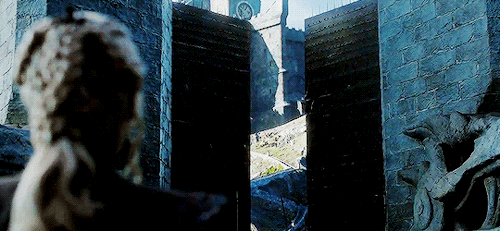
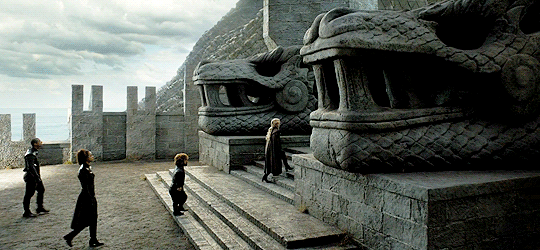
In the books, she’s still in Essos and it will be interesting to see whether she follows the same path as the show. However, thematically and symbolically, there’s a strong argument for Daenerys first returning to Dragonstone in the books as well. Fx Dany deliberately evokes the conquering trio when she sails from Qarth to acquire an army for her (re)conquest:
Three heads has the dragon, Dany thought, wondering. “I shall tell my people to make ready to depart at once. But the ships that bring me home must bear different names.”“As you wish,” said Arstan. “What names would you prefer?” "Vhagar,” Daenerys told him. “Meraxes. And Balerion. Paint the names on their hulls in golden letters three feet high, Arstan. I want every man who sees them to know the dragons are returned.” (ACoK, Daenerys V)
Vhagar, Meraxes and Balerion were the names of the dragons that Visenya, Rhaenys and Aegon the Conqueror rode when they conquered Westeros, the very creatures that made the Conquest possible.
Even Drogon, Daenerys’ draconic mount, has several similarities with Aegon’s dragon, Balerion the Black Dread. Like Balerion, Drogon’s scales and flame are black. He is also the largest of Dany’s three dragons, just like Balerion was the largest of the three Targaryen dragons that conquered Westeros.
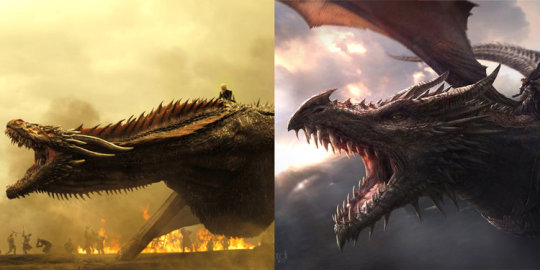
Furthermore, the text itself explicitly likens Drogon to Balerion.
“Aegon’s dragons were named for the gods of Old Valyria,” she told her bloodriders one morning after a long night’s journey. “Visenya’s dragon was Vhagar, Rhaenys had Meraxes, and Aegon rode Balerion, the Black Dread. It was said that Vhagar’s breath was so hot that it could melt a knight’s armor and cook the man inside, that Meraxes swallowed horses whole, and Balerion … his fire was as black as his scales, his wings so vast that whole towns were swallowed up in their shadow when he passed overhead."The Dothraki looked at her hatchlings uneasily. The largest of her three was shiny black, his scales slashed with streaks of vivid scarlet to match his wings and horns. "Khaleesi,” Aggo murmured, “there sits Balerion, come again.” (ACoK, Daenerys I)
The text also explicitly compares Daenerys to Aegon the Conqueror. Tyrion crudely calls her “Aegon the Conqueror with teats” (ADwD, Tyrion VI) and even Dany compares herself to her illustrious ancestor:
No one was calling her Daenerys the Conqueror yet, but perhaps they would. Aegon the Conqueror had won Westeros with three dragons, but she had taken Meereen with sewer rats and a wooden cock, in less than a day. (ASoS, Daenerys VI)

(Aegon the Conqueror on the Iron Throne. Art from Game of Thrones WIKI)
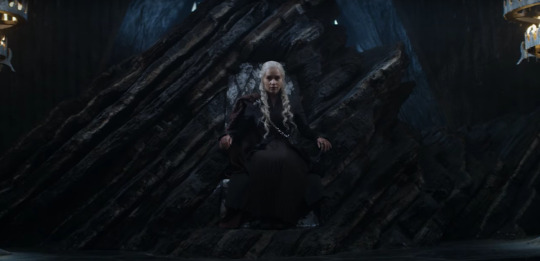
There’s another narrative parallel between Daenerys and Aegon the Conqueror though it is a little known one. Even though Aegon had turned his attention towards Westeros at an early age, he became embroiled in the political conflict between Volantis, Pentos and Lys in Essos where he intervened against Volantis.
As for Aegon Targaryen, shortly after his role in defeating Volantis it is written that he lost all interest in the affairs of the east. Believing Volantis's rule at an end, he flew back to Dragonstone. And now, no longer distracted by the wars of Essos, he turned his gaze west. (TWoIaF, Ancient History: The Doom of Valyria)
This matches the structure of Daenerys’ narrative arc. She sets her eye on Westeros after Viserys’ death but then she gets sidetracked on her main quest when she intervenes militarily and politically in Slaver’s Bay. Since the show has now moved beyond the published material, it is confirmed that Dany once again turns her eye west, just like Aegon I (she’ll get there in the books as well).
The many parallels between Daenerys Targaryen and Aegon the Conqueror teases the idea of history repeating itself, which is a theme that is addressed in the text.
“Archmaester Rigney once wrote that history is a wheel, for the nature of man is fundamentally unchanging. What has happened before will perforce happen again, he said.” (Roderik Harlaw to Asha Greyjoy - AFfC, The Kraken’s Daughter)
The quote above cites human nature as the reason for history repeating itself and there’s a certain truth in that. However, when we look at the larger narrative structure, the notion of history repeating itself becomes a different issue. The parallels between Daenerys and Aegon the Conqueror tease a Targaryen restoration but in terms of narrative structure, a repeat performance of the Targaryen invasion of Westeros right down to a victory and Targaryen supremacy strikes me as narratively unsatisfying, especially since Daenerys is repeating the mistakes of her ancestors as @lostlittlesatellites argues in this meta, thus perpetuating the cycle that first the Doom and then Robert’s Rebellion put a temporary end to. Furthermore, having history repeat itself in a straight-forward manner doesn’t really fit with a storyteller like GRRM who writes in the ironic mode. So if history is to repeat itself with Daenerys’ invasion of Westeros, then she is bound to fail. Where Aegon the Conqueror was the founder of House Targaryen as a royal Westerosi dynasty, Daenerys will be the end of the Targaryen dynasty all together. There’s textual evidence for the latter statement but this will have to be the subject of another post.
THREE TARGARYEN CLAIMANTS?
If Dany represents the inversion of Aegon I (even down to the dreadful black dragon), then she lacks inverted figures of the sister-wives. Her brothers are all dead but she has one or possibly two hidden nephews in Jon Snow and (f)Aegon. But if this is to be a true inversion, then the three Targaryen heads cannot be in accord like Aegon I and his sisters. Dany approaches the prophecy of the Three Heads of the Dragon with a wistful sense of longing - a longing for family but also a dream of being able to trust someone unconditionally. However, the issue of trust is not just about who she can trust but also whether she really is able to trust anyone at all due to her fear of betrayal.
Her bloodriders were waiting for her. Silver bells tinkled in their oiled braids, and they wore the gold and jewels of dead men. Meereen had been rich beyond imagining. Even her sellswords seemed sated, at least for now. Across the room, Grey Worm wore the plain uniform of the Unsullied, his spiked bronze cap beneath one arm. These at least she could rely on, or so she hoped … and Brown Ben Plumm as well, solid Ben with his grey-white hair and weathered face, so beloved of her dragons. And Daario beside him, glittering in gold. Daario and Ben Plumm, Grey Worm, Irri, Jhiqui, Missandei … as she looked at them Dany found herself wondering which of them would betray her next. The dragon has three heads. There are two men in the world who I can trust, if I can find them. I will not be alone then. We will be three against the world, like Aegon and his sisters. (ASoS, Daenerys IV)
Daenerys fears treason because of the prophecy in the HotU. The prophecy of the three treasons is a niggling mindworm feeding a certain sense of paranoia - yet she also dreams of two heads on the family body that she can trust.
The quote above is the second time the notion of the Three Heads of the Dragon is related to the idea of betrayal! The first instance was the prophecy itself, which I noted in my previous post.
Another part of the visions and prophecies in the House of the Undying relates to three lies that she will “slay”, which I interpret that Daenerys will be the catalyst for uncovering the truth behind three untruths:
Glowing like sunset, a red sword was raised in the hand of a blue-eyed king who cast no shadow. A cloth dragon swayed on poles amidst a cheering crowd. From a smoking tower, a great stone beast took wing, breathing shadow fire. . . . mother of dragons, slayer of lies (ACoK, Daenerys IV)
In this context, it is the second vision/lie that is important: The Mummer’s Dragon.
A mummer's dragon, you said. What is a mummer's dragon, pray?" "A cloth dragon on poles," Dany explained. "Mummers use them in their follies, to give the heroes something to fight." (ACoK, Daenerys V)
A mummer’s dragon is a counterfeit dragon, and this fits with (f)Aegon not being who he thinks he is. There’s also the added meaning of (f)Aegon being Varys’ pawn - and Varys was part of a mummer’s troupe in his youth. Varys is the Mummer and (f)Aegon is his counterfeit Dragon.

Finally, the phrase “a cloth dragon on poles” also evokes the image of the Targaryen dragon banner, raised by a competing claimaint to the Iron Throne. This is exactly what (f)Aegon does, spurred on by Tyrion, in A Dance with Dragons where he invades Westeros with Jon Connington and the Golden Company.
"Perhaps I overstated. She may take pity on you when you come begging for her hand." The dwarf shrugged. "Do you want to wager your throne upon a woman's whim? Go to Westeros, though … ah, then you are a rebel, not a beggar. Bold, reckless, a true scion of House Targaryen, walking in the footsteps of Aegon the Conqueror. A dragon."I told you, I know our little queen. Let her hear that her brother Rhaegar's murdered son is still alive, that this brave boy has raised the dragon standard of her forebears in Westeros once more, that he is fighting a desperate war to avenge his father and reclaim the Iron Throne for House Targaryen, hard-pressed on every side … and she will fly to your side as fast as wind and water can carry her. You are the last of her line, and this Mother of Dragons, this Breaker of Chains, is above all a rescuer. The girl who drowned the slaver cities in blood rather than leave strangers to their chains can scarcely abandon her own brother's son in his hour of peril. And when she reaches Westeros, and meets you for the first time, you will meet as equals, man and woman, not queen and supplicant. How can she help but love you then, I ask you?" Smiling, he seized his dragon, flew it across the board. "I hope Your Grace will pardon me. Your king is trapped. Death in four." (Tyrion to Young Griff/Aegon - ADwD, Tyrion VI)
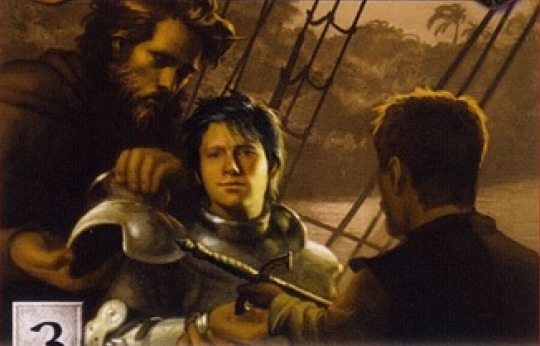
(Young Griff. Art by Winona Nelson)
Tyrion suggests this strategy as a means to impress Daenerys Targaryen as he suspects that she won’t react well if (f)Aegon comes to her as a suitor and a supplicant:
Now, how do you suppose this queen will react when you turn up with your begging bowl in hand and say, 'Good morrow to you, Auntie. I am your nephew, Aegon, returned from the dead. I've been hiding on a poleboat all my life, but now I've washed the blue dye from my hair and I'd like a dragon, please … and oh, did I mention, my claim to the Iron Throne is stronger than your own?' " (Tyrion to Young Griff/Aegon - ADwD, Tyrion VI)
What Tyrion fails to take into account is that Daenerys may not react favourably to anyone who has a better claim to the Iron Throne than her. She’s hardly a woman who will be satisfied with playing the role of Queen Consort instead of Queen Regnant, especially since she’s already have had a taste of power as a sole ruler. However much Dany might long for dragonrider consorts that she can trust implicitly, the political circumstances surrounding her (possible) future meeting with (f)Aegon will more likely result in conflict than in unity between them.
We must remember that (f)Aegon is Varys’ pawn, his attempt to create a perfect king and though Varys also schemed with Magister Illyrio about Viserys, Daenerys and the Dothraki, the existence of (f)Aegon and the attempt to mould him into the perfect king proves that Varys never intended Viserys to claim the Iron Throne. So what was Varys’ purpose to scheme for Viserys to get an army? The biggest hurdle for (f)Aegon’s campaign is that people believe that Prince Rhaegar’s infant son died with his mother and sister during the Sack of King’s Landing. People will therefore be suspicious of (f)Aegon and he needs allies among the great Houses of Westeros. In this context, Viserys would have acted as the terrifying alternative - the Mad King’s son backed by a Dothraki army, known for raping and reaving. Faced with such an alternative, a pretender of dubious origin like (f)Aegon would look much more inviting. Viserys died but Daenerys will likely end up cast as the fearsome foreign invader in the mummer’s play that Varys is staging. She’ll come with an army of Unsullied (and very likely Dothraki horsemen) - the Mad King’s daughter with three dragons and an army of foreign “savages”.
The narrative in both A Dance with Dragons and in the as yet unpublished The Winds of Winter is setting up a future conflict between Daenerys and (f)Aegon.
"Prince Aegon," said Tristan Rivers, "we are your men. Is this your wish, that we sail west instead of east?" "It is," Aegon replied eagerly. "If my aunt wants Meereen, she's welcome to it. I will claim the Iron Throne by myself, with your swords and your allegiance. Move fast and strike hard, and we can win some easy victories before the Lannisters even know that we have landed. That will bring others to our cause." (ADwD, The Lost Lord)
In chapter previews from The Winds of Winter, the text raises the spectre of a second Dance of Dragons, i.e. a civil war between Targaryen claimants to the Iron Throne - something that GRRM himself has coyly referred to in interviews (x).
"Dragons?" said her mother. "Teora, don't be mad." "I'm not. They're coming." "How could you possibly know that?" her sister asked, with a note of scorn in her voice. "One of your little dreams?" Teora gave a tiny nod, chin trembling. "They were dancing. In my dream. And everywhere the dragons danced the people died." (TWoW, Arianne I)
The quote above is from one of these previews (Arianne I) where Arianne Martell is travelling to meet Jon Conning and (f)Aegon in order learn the truth about the Targaryen pretender and then to decide whether Dorne shall ally itself with them against the Lannisters and little King Tommen. The girl in question, Teora Toland appears to have prophectic dreams.
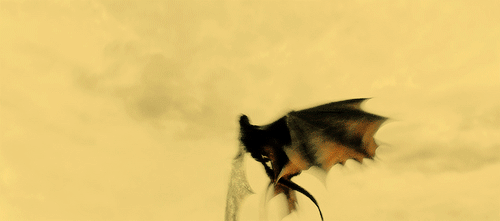
As I’ve said, (f)Aegon is most likely false coin but the Martells may decide to ally with him anyway when they learn that not only did Quentyn Martell not secure an alliance with Daenerys Targaryen but her dragons also became his death. Arienne already mistrusts Daenerys on account of Khal Drogo’s murder of Viserys Targaryen as well as her being the Mad King’s daughter:
The secret pact that Prince Doran had made all those years called for Arianne to be wed to Prince Viserys, not Quentyn to Daenerys. It had all come undone on the Dothraki sea, when he was murdered. Crowned with a pot of molten gold. "He was killed by a Dothraki khal," said Arianne. "The dragon queen's own husband." "So I've heard. What of it?" "Just... why did Daenerys let it happen? Viserys was her brother. All that remained of her own blood." "The Dothraki are a savage folk. Who can know why they kill? Perhaps Viserys wiped his arse with the wrong hand." Perhaps, thought Arianne, or perhaps Daenerys realized that once her brother was crowned and wed to me, she would be doomed to spend the rest of her life sleeping in a tent and smelling like a horse. "She is the Mad King's daughter," the princess said. "How do we do know -- " "We cannot know," Ser Daemon said. "We can only hope." (TWoW, Arianne I)
Thus, the stage is set for a bloody confrontation between Daenerys and (f)Aegon when she reaches the shores of Westeros. Instead of unity, there’ll be war between two of the heads of the Targaryen dragon. In this respect it doesn’t matter that (f)Aegon is not a true Targaryen and even GRRM has said that “the third [head] will not necessarily BE a Targaryen…” (GRRM).
What purpose does (f)Aegon serve in the narrative? He is, in a sense, a metatextual commentary on the trope of the Hidden Heir, but at the same time he is also a foil to Jon Snow, who is a genuine hidden heir. In terms of narrative structure, (f)Aegon has to be false coin - however, his existence as well as him pressing his claim to the Iron Throne may very well influence Daenerys’ reaction to the revelation of Jon Snow’s true heritage in a negative manner. After (f)Aegon, Daenerys will most likely be extremely suspicious when yet another hidden Targaryen prince is unveiled and if this suspicion is combined with her paranoid belief in the prophecised treasons, then that’s a recipe for disaster.
In this context it is worth taking another look at the visions associated with the Slayer of Lies from the House of the Undying:
From a smoking tower, a great stone beast took wing, breathing shadow fire. . . . (ACoK, Daenerys IV)
The third lie that Daenerys will “slay” relates to a winged stone beast that breathes shadow fire like a dragon. I have previously argued that the stone beast represents Jon with his dual heritage of wolf (Stark) and Targaryen (Dragon). I’m not the only one who thinks that the stone beast represents Jon. The poster lollygag makes the same argument (but from different textual evidence) on westeros.org. Jon’s true parentage is undoubtedly one of the greatest secrets in the whole story. Ned Stark told a lie to cover a treason and the revelation of Jon Snow as the son of Rhaegar Targaryen will have a profound effect on the political game in the story - in the North, in relation to Daenerys and quite possibly to the realm at large. Narratively, it makes sense for Jon’s parentage to be the third secret that Daenerys will “slay” since Jon will have a greater claim than her to the Iron Throne by virtue of this parentage.
Will this Second Dance of Dragons also include Jon? Will Jon and Daenerys clash when his true parentage is revealed? Jon doesn’t want the Iron Throne but Dany will probably be suspicious after her experiences with (f)Aegon. Then there’s the fact that the show appears to be foreshadowing a clash between Targaryens.

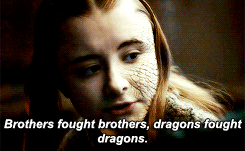
In season 5, Shireen Baratheon reads about the first Dance of Dragons and then discusses that tragic piece of Westerosi history with her father Stannis Baratheon. In season 2, Stannis entered into a small-scale Baratheon version of a similar conflict because his younger brother Renly made a bid for the Iron Throne. However, that conflict was resolved with Renly’s murder in season 2 so you have to wonder why a conflict of succession between family members is brought up several seasons later - unless it is to foreshadow a future conflict between Jon and Daenerys. This interpretation is supported by the fact that the show tends to use stories as devices of foreshadowing. In season 3, Bran’s tale of the Rat Cook foreshadows both the Red Wedding as well as Arya’s revenge when she serves Walder Frey a pie made of his sons in season 7. In season 3, Shireen brings ser Davos a book about Aegon the Conqueror and his dragons when he sits in the dungeons of Dragonstone and the story she tells foreshadows Daenerys’ return to the very same place in season 7.
Some people argue that the show has simply given (f)Aegon’s storyline to Jon. That is a valid argument but a specific utterance by GRRM makes me believe that a Second Dance of Dragons will involve Jon at some point in the books as well:
I’ve been always very impressed by Homer and his Iliad, especially the scene of the fight between Achilles and Hector. Who is the hero and who is the villain? That’s the power of the story and I wanted something similar to my books. The hero of one side is the villain of the other side. (GRRM)
This is a very interesting quote in the context of a Second Dance of Dragons. I’ve demonstrated that the stage is set for a conflict between Daenerys and (f)Aegon. However, (f)Aegon has nowhere near the narrative weight of a Hector or an Achilles. He is introduced too late in the story for that. However, we must remember that (f)Aegon also serves as a foil to Jon in relation to the trope of the Hidden Prince. @randomtvramblings has argued that Jon embodies the qualities of the ideal king that Varys is trying to mould (f)Aegon into. (f)Aegon is Jon’s mirror - the false coin to Jon as the true prince. Furthermore, Jon is the only other character that has the narrative weight to play the Hector (defender) to Daenerys’ Achilles (invader). Both characters are among the central protagonists of the story and they are both considered heroic - but what happens if one becomes an antagonist to the other? Then “the hero of one side becomes the villain of the other side” as GRRM so eloquently puts it.
A Second Dance of Dragons involving all three Targaryen claimants would not only present an interesting and ironic twist on the prophecy of the Three Heads of the Dragons, it would also play into the theme of trust and betrayal that runs through Daenerys’ arc. She longs for family, people that she can trust implicitly and thus she casts those imaginary men as her fellow dragonriders. However, the political reality of Westeros will most certainly shatter that dream of trust and companionship, and Daenerys’ increasing fear of betrayal will most likely add fuel to the fire.
DAENERYS AND HER THREE DRAGONS?
Could there be other meanings to the prophecy of the Three Heads of the Dragon than future dragonriders and secret Targaryens? Curiously enough Daenerys and her dragons are referred to as one entity twice in the text:
The eunuch drew a parchment from his sleeve. “A kraken has been seen off the Fingers.” He giggled. “Not a Greyjoy, mind you, a true kraken. It attacked an Ibbenese whaler and pulled it under. There is fighting on the Stepstones, and a new war between Tyrosh and Lys seems likely. Both hope to win Myr as ally. Sailors back from the Jade Sea report that a three-headed dragon has hatched in Qarth, and is the wonder of that city—” “Dragons and krakens do not interest me, regardless of the number of their heads,” said Lord Tywin. (ASoS, Tyrion III)
The text does something interesting here. The kraken is the sigil of House Greyjoy. Varys makes the connection explicit and then says “not a Greyjoy, mind you, a true kraken”. Then he relates the news about a three-headed dragon hatched in Qarth - to Tywin that sounds like yet another mythical creature, just like the krakens, but we know that this refers to Dany and her three dragons. So the text first mentions two mythical creatures that are used as heraldic sigils have been sighted. The kraken may be real or not - that’s not what is important here. The important part is the three-headed dragon in Qarth.
The second mention of Daenerys as a three-headed dragon occurs in A Dance With Dragons in a conversation between Tyrion and Magister Illyrio in Pentos:
“When men are starving and sick of fear, they look for a savior." "They may look, but if all they find is Stannis —" "Not Stannis. Nor Myrcella." The yellow smile widened. "Another. Stronger than Tommen, gentler than Stannis, with a better claim than the girl Myrcella. A savior come from across the sea to bind up the wounds of bleeding Westeros." "Fine words." Tyrion was unimpressed. "Words are wind. Who is this bloody savior?" "A dragon." The cheesemonger saw the look on his face at that, and laughed. "A dragon with three heads." (ADwD, Tyrion I)
Magister Illyrio is, of course, referring to Daenerys Targaryen and her three dragons.

(Daenerys Targaryen with her dragons. Art by Yama Orce)
That is twice that Daenerys is described as the literal embodiment of her house sigil!
Could it be that the prophecy of the Three Heads of the Dragon simply refer to Daenerys herself and her three dragons? A symbolic dragon (Daenerys as a Targaryen dragonlord) with three literal dragons. Remember that the Targaryens often were described as Dragons. The Conqueror, the ancestor that Daenerys shares so many parallels with, is sometimes called Aegon the Dragon!
"When Aegon the Dragon stepped ashore in Westeros, the kings of Vale and Rock and Reach did not rush to hand him their crowns. If you mean to sit his Iron Throne, you must win it as he did, with steel and dragonfire. And that will mean blood on your hands before the thing is done. "Blood and fire, thought Dany. The words of House Targaryen. (ASoS, Daenerys II)
Throughout the books Daenerys increasingly begins to refer to herself as a dragon, especially in A Dance with Dragons, where her special connection with Drogon also is emphasized.
"I am the blood of the dragon," she whispered aloud as she followed, trying to keep her courage up. "I am the blood of the dragon. I am the blood of the dragon." The dragon was never afraid. (AGoT, Daenerys II)
She had them nailed to wooden posts around the plaza, each man pointing at the next. The anger was fierce and hot inside her when she gave the command; it made her feel like an avenging dragon. (ASoS, Daenerys IV)
"I am the blood of the dragon," Dany reminded him. "Have you ever seen a dragon with the flux?" Viserys had oft claimed that Targaryens were untroubled by the pestilences that afflicted common men, and so far as she could tell, it was true. She could remember being cold and hungry and afraid, but never sick. (ADwD, Daenerys VI)
"They are … they are fearsome creatures." "They are dragons, Quentyn." Dany stood on her toes and kissed him lightly, once on each cheek. "And so am I." (ADwD, Daenerys VIII)
Drogon raised his head, blood dripping from his teeth. The hero leapt onto his back and drove the iron spearpoint down at the base of the dragon's long scaled neck. Dany and Drogon screamed as one. [...] The dragon gave one last hiss and stretched out flat upon his belly. Black blood was flowing from the wound where the spear had pierced him, smoking where it dripped onto the scorched sands. He is fire made flesh, she thought, and so am I. (ADwD, Daenerys IX)
If she had not been so sick and scared, that might have come as a relief. Instead she began to shiver violently. She rubbed her fingers through the dirt, and grabbed a handful of grass to wipe between her legs. The dragon does not weep. (ADwD, Daenerys X)
I find the casting of Daenerys as a dragon in the symbolic sense interesting in relation to the prophecy of the Three Heads of the Dragon. Clues in the text indicate that Rhaegar thought that he had to recreate the original sibling trio of Rhaenys - Aegon - Visenya; the three dragon heads of the Targaryen sigil. Daenerys (and perhaps Aemon) thinks that the three heads are three dragon riders, like the original trio. However prophecy is a tricky beast in GRRM’s world:
Prophecy is one of those tropes of Fantasy that is fun to play with, but it can easily turn into a straightjacket if you’re not careful. One of the themes of my fiction, since the very beginning, is that the characters must make their choices, for good or ill. And making choices is hard. There are prophecies in my Seven Kingdoms, but their meanings are often murky and misleading, and they seldom offer the characters much in the way of useful guidance. (GRRM)
Indeed the text itself reminds us of this:
“Prophecy is like a half-trained mule,” he complained to Jorah Mormont. “It looks as though it might be useful, but the moment you trust in it, it kicks you in the head.” (ADwD, Tyrion IX)
Could it be that the Three Heads of the Dragon is to be understood as a mix of the symbolic and the literal? The Targaryens were called dragons because they were dragonriders. However, Dany is a bit unusual in relation to a her dragon-riding ancestors because she is one Targaryen with 3 dragons. However, GRRM himself has hinted that the three heads of the dragons will be three persons though not all of them Targaryens:
“Three heads of the dragon… yes… but the third will not necessarily BE a Targaryen…” (GRRM)
This seems to contradict my theory that the prophecy may simply refer to Dany and her three dragons, but GRRM has also said that:
Prophecies are, you know, a double edge sword. You have to handle them very carefully; I mean, they can add depth and interest to a book, but you don’t want to be too literal or too easy… In the Wars of the Roses, that you mentioned, there was one Lord who had been prophesied he would die beneath the walls of a certain castle and he was superstitious at that sort of walls, so he never came anyway near that castle. He stayed thousands of leagues away from that particular castle because of the prophecy. However, he was killed in the first battle of St. Paul de Vence and when they found him dead he was outside of an inn whose sign was the picture of that castle! So you know? That’s the way prophecies come true in unexpected ways. The more you try to avoid them, the more you are making them true, and I make a little fun with that. (GRRM)
This quote makes me think of a much more mundane interpretation. There are no real three-headed dragons so the dragon that has the three heads is symbolic. Rhaegar and Aemon interpreted the Dragon as House Targaryen but the Dragon could also be one single person: the Last Dragonlord, Daenerys Targaryen and the three heads her actual dragons, the source of her power and the source of her queenship, which is literally represented by the three-headed dragon crown that she wears.
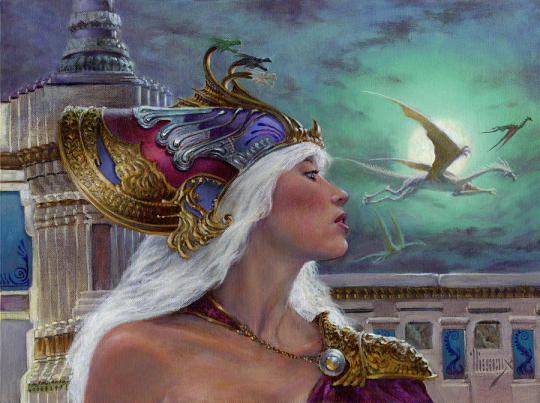
(The Dragon Crown. Art by Richard Hescox)
This crown is given quite a bit of narrative weight as it is mentioned several times throughout the series.
And the Tourmaline Brotherhood pressed on her a crown wrought in the shape of a three-headed dragon; the coils were yellow gold, the wings silver, the heads carved from jade, ivory, and onyx.The crown was the only offering she’d kept. The rest she sold, to gather the wealth she had wasted on the Pureborn. Xaro would have sold the crown too—the Thirteen would see that she had a much finer one, he swore—but Dany forbade it. “Viserys sold my mother’s crown, and men called him a beggar. I shall keep this one, so men will call me a queen.” And so she did, though the weight of it made her neck ache. (ACoK, Daenerys III)
“Your pretty crown might buy another century,” said the fat one in Valyrian. “Your crown of the three dragons."Dany waited for his words to be translated. "My crown is not for sale.” When Viserys sold their mother’s crown, the last joy had gone from him, leaving only rage.” (ASoS, Daenerys III)
Today she wore a robe of purple samite and a silver sash, and on her head the three-headed dragon crown the Tourmaline Brotherhood had given her in Qarth. (ASoS, Daenerys VI)
Irri fetched her crown, wrought in the shape of the three-headed dragon of her House. Its coils were gold, its wings silver, its three heads ivory, onyx, and jade. Dany’s neck and shoulders would be stiff and sore from the weight of it before the day was done. A crown should not sit easy on the head. One of her royal forebears had said that, once. (ADwD, Daenerys I)
So I’d say that it is quite possible that the prophecy of the Dragon’s Three Heads may simply refer to Daenerys herself and her three dragons but her actions may very well turn the prophecy into an ironic twist on her own interpretation of trustworthy dragonriders.
The concept of a self-fulling prophecy is an interesting one because when a character believes in a prophecy, it influences how she thinks and acts. This is exemplified most clearly with Cersei but Dany believes in her prophecies as well - and I have demonstrated how it influences her thinking. She thinks that the prophecy of the Three Heads of the Dragon means three dragonriders: herself and two men she hasn’t yet found - and then the text introduces one supposed Targaryen (fAegon) in hiding whilst it has hinted at a true Targaryen in hiding from the beginning (Jon). So when she meets them the prophecy will influence her actions even if she interprets it wrongly, just like Rhaegar most likely did since his rather literal attempt to recreate the Rhaenys-Aegon-Visenya trio failed. Thus, the prophecy can come to mean several things at the same time as it affects things personal, things political and things magical.
(GIFs and edits not mine)
#asoaif#meta#the three heads of the dragon#daenerys targaryen#young griff#f!aegon#jon snow#dance of dragons#prophecy#aegon the conqueror
125 notes
·
View notes
Photo
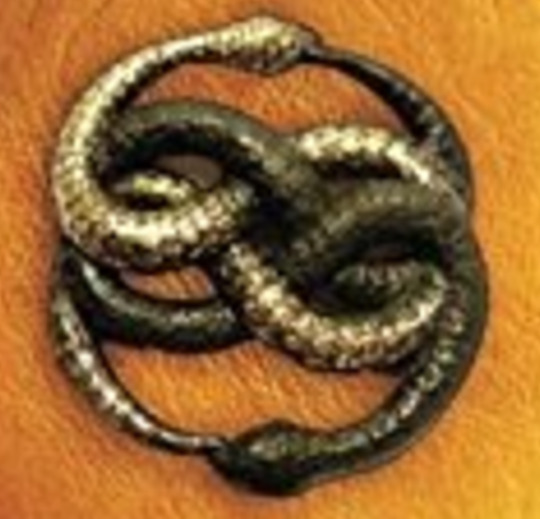

2. The Neverending Story -
Muse/Lord & The rules of Paradox Space
[Spoilers for The Neverending Story]

I’m not the first to note Homestuck’s references to AURYN, the magical amulet from The Neverending Story. The symbol of the intertwined black and white snakes is directly referenced only twice in Homestuck’s story, and both times it tells us a mind-boggling amount about the nature and function of Homestuck’s universe.
And even that only scratches the surface. So instead of starting off with Homestuck itself, let me tell you a little bit about The Neverending Story itself.

The Neverending Story is a book split in two. In the most commonly printed version, it comes in Red and Green text halves. The real world, the realm of humans where you and I live--those sections are printed in Red. Fantastica, the world of fiction and stories and all things imaginary, is printed in green.
And as with two sections, The Neverending Story is split into two central figures:
The Childlike Empress, and Bastian Balthazar Bux.
Muse & Lord
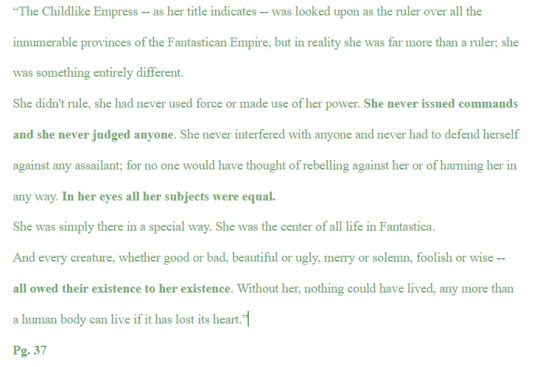
In the green-lettered plains of Fantastica, The Childlike Empress rules over all. Although her authority is accepted by even the most evil and mostrous in Fantastica, she never gives orders. Even so, she is both eternal and eternally childlike. Good and evil are equal in her eyes.
Sometimes called the Golden-Eyed Commander of Wishes, The Childlike Empress’ authority only manifests when she grants her gem of wish-fulfilling powers--AURYN--to another. This other is treated as though the Empress herself were present, and acts as an emmisary for her.
She is the embodiment of Fantasy itself, inspiring others to act out her will.
She is a question, a mystery, a wonder. She is, in short...A Muse.
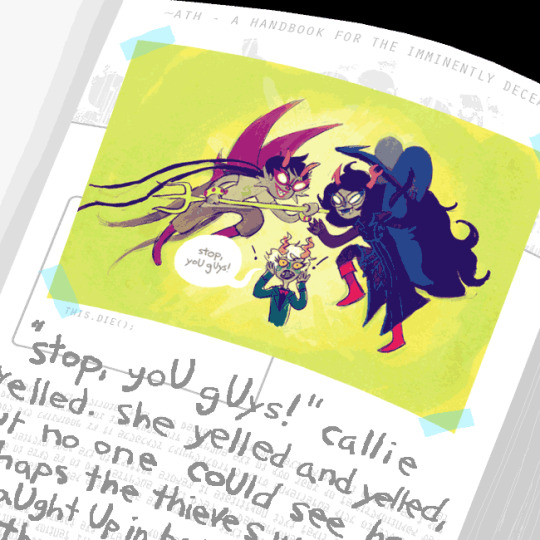
And she has a direct parallel in Calliope, who similarly draws no distinction between good and evil (people forget that she read what was likely the worst of Vriska without being exposed to her growth, and seemingly wanted to be friends with her anyway)...
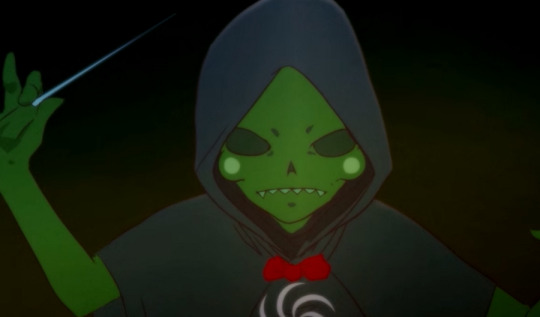
And who similarly has absolute power over reality, yet never gives orders, even as the entire narrative is shaped around her. Just as with the Childlike Empress, without Calliope’s existence, none of the other characters in the comic can exist either.
Everyone is entangled in and created by Lord English’s Alpha Timeline, but that web is Calliope’s as well, and she’s causally entangled in the creation of all four of the universes we follow.
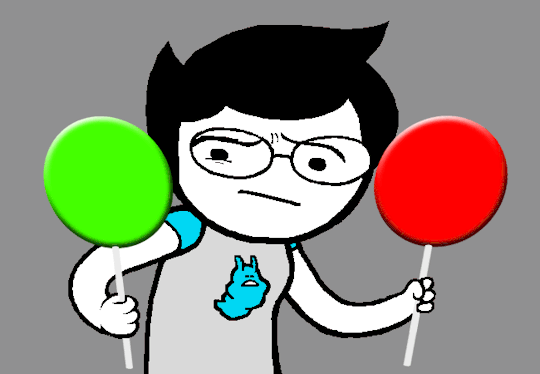
And again like the Childlike Empress, Calliope who bestows her Symbol on others, granting AURYN to humans--an emblem which endows in the wearer the ability to make any wish come true.
Hell, Calliope even seems not to grow up normally in Act 7 and [S] Credits.
A Childlike Empress indeed. And as for her counterpart? Bastian may not be as much of a jerk as Caliborn, but the parallels between them are even more explicit:

Where The Childlike Empress is a Muse only by implication,
Bastian is textually and demonstrably a Lord.
But let’s back up a bit.
Bastian Balthazar Bux is a little boy who steals a book named “The Neverending Story” from a bookshop and hides in his school to read it in one sitting.
His sections, those taking place in the Human world, typically feature text colored Red.
However, around the halfway point of The Neverending Story, he realizes that the story is not only aware of him, but calling out to him. And he eventually finds himself pulled into the realm of Fantastica.
Bastian is a human, you see, and only humans can create stories--the inhabitants of Fantastica themselves cannot. And once the Childlike Empress is reborn with a new name, Fantastica must be reborn as well. So The Childlike Empress meets Bastian in the void between the two realms of Fantastica, and gives him the amulet AURYN, the symbol of her power.
And so, she entrusts him with a quest:
To fulfill his wishes in Fantastica, and re-create the realm of Fantasy as he goes.

Incidentally, receiving AURYN also changes Bastian’s race. Bastian is explicitly white, but upon arriving in Fantastica transforms into “a young prince from the Orient”. I’m not sure why that even happens, to be honest? Let’s note that this book is from, like, 1979 and definitely not perfect.
Anyway, I only mention it because this lends some credence to my assertion that Trickster Mode’s whiteness is not at all tied to the “actual race” of the kids-- since whatever that race is, changing it would be within AURYN’s power.
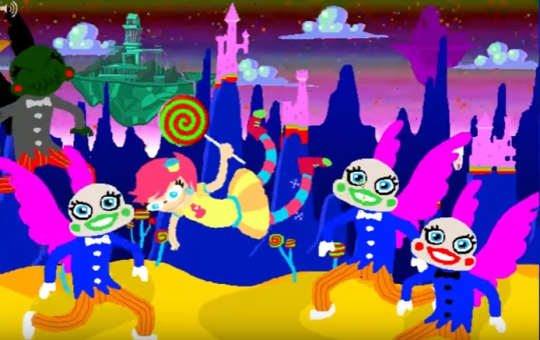
To be honest, I should’ve noted that was explicit earlier, since Homestuck all but explicitly states that Tricksterfied Cherubs would look like Lil Cal, which definitely entails a primary skin color swap. And there, as with Humans, the transformation always renders the subject Caucasian-looking.
Now, where were we?

Ah, right. So, the first thing you might notice is that Bastian’s ascent to Lordship also coincides with him leaving the World of Men and entering the World of Fantasy/Ideas.

Which strikes his first echo with Caliborn. Both characters’ entries into power are marked by changing their text color to Green--the color of their respective Muse figures. And like Calliope dies for Caliborn to Enter, The Childlike Empress disappears from Fantastica as soon as Bastian becomes it’s Lord.
Bastian spends most of his adventure in the realm seeking to meet her once more, on some level--just as Lord English spends an eternity in the Void, trying to find and destroy the Calliopes.

And during his search, Bastian also accrues subjects and followers who carry out his will. Bastian is adored for his ability to create stories--which instantly become Real-- across Fantastica. With The Childlike Empress’ AURYN around his neck, nothing can resist his will. Bastian becomes, for all intents and purposes, a God.
Although he loses his humanity little by little with every wish he makes.
The memory of being weak, the memory of being ugly, the memory of being scared-- as Bastian travels, he grows more self-satisfied and arrogant, desiring the adoration of others without true regard for their feelings and hearts.

Until in the end, he’s exploiting those he calls friends through sheer force of will.
At this point, Bastian seeks to replace The Childlike Empress entirely, attempting to become the Childlike Emperor--just as Lord English seeks to emulate Calliope through a multitude of stylistic choices in his personal aesthetic.
I think banditAffiliate puts it well in this forum post:
“Doc Scratch was born to serve as Lord English's other half, replacing the role Calliope served when the two shared one body. From Caliborn's warped perspective, the two share many similarities. They're both wordy, intelligent, and (as Caliborn saw her) quite smug. He scrapbooks with a ~ATH book like she did, and carries her weapon.
In addition to being a pastiche of his sister, Scratch is also a symbol of his other weakness, the cue ball. Both are heralded to be the key to his defeat, after all. He does double duty then by killing Scratch, hatching out of his body and growing more powerful (by assimilating Scratch's first guardian powers), "predominating" over him and asserting his dominance over both his vulnerabilities once again.”
And Bastian, well...
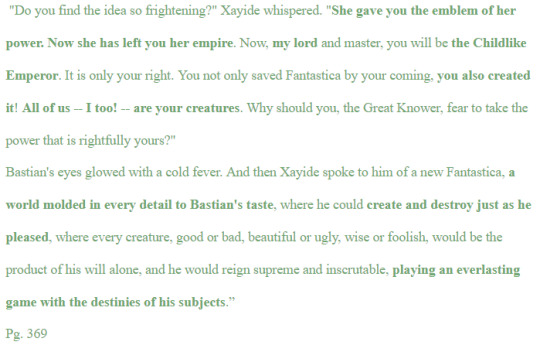

Sound familiar at all?
By the end, Bastian is at risk of becoming what is essentially a Yaldabaoth--an arrogant God with full dominion over his material reality, but blind to the world of ideas outside of him.
Luckily, Bastian escapes this fate, and goes on to live a happy life, becoming a world-renowed storyteller. His path is not the path of the Lord forever. But that is another story, and shall be told another time.
There’s one last thing to note about AURYN, because it appears in two places in Homestuck. There’s the Lollipop, yes--and by linking AURYN to the Cherubs, we learn a great deal about both Muse and Lord, Calliope and Caliborn.
But AURYN’s impact is a bit more far-reaching than just them.
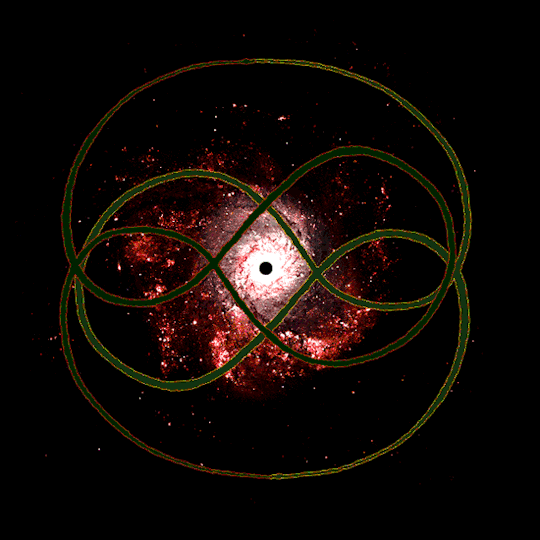
The emblem is also depicted during the mating ritual of Cherubs, remember? And it’s important to view this image in context, because as Aranea tells us...

Mating Cherubs tap into the forces of power presiding over all that is eternal. Cherubs are linked to the primordial forces of reality by their nature. The source of Cherub’s powers is their intrinsic connection to the flow and nature of reality.
Which suggests that the principle that AURYN is inscribed with, the principle that guides the power of its magic, is also the fundamental principle of Homestuck’s universe. Cherubs are simply beings with a unique ability to tap directly into it. And that principle is...
“Do As You Will.”
Nothing in Homestuck’s reality happens except by the Will of someone living inside it. Individual will is the backbone of all events and objects, all circumstances and beings, all people and universes in Homestuck.
In Homestuck, everybody always gets what they want--one way or another.
That is what AURYN-- placed here, at the center of the forces of creation and destruction-- suggests. A good example of this is Lord English’s creation, where Caliborn and Gamzee’s wills to become Lord English meet Arquis’ desire to have a heroic moment of unfathomable impact onto reality:
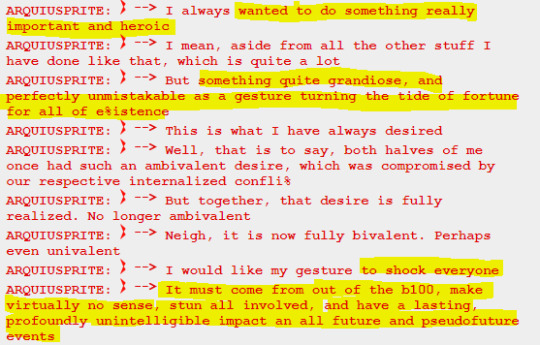
Thus resulting in a scenario that fulfills all of their desires, and results in the creation of Lord English and Doc Scratch:
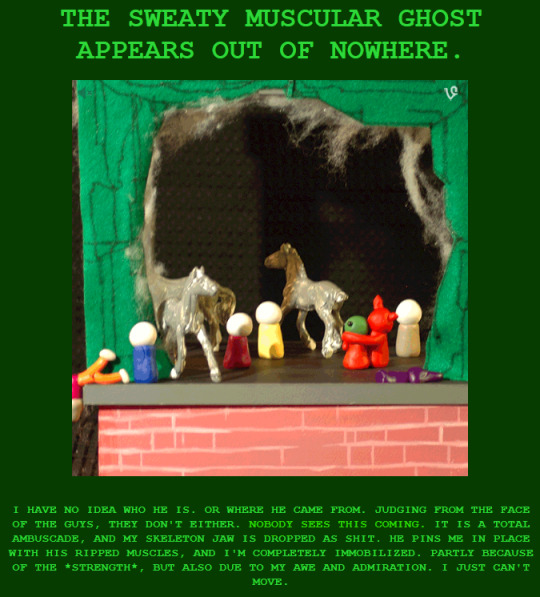
I’m not going to list a bunch of other examples because this kind of stuff is literally always what happens in Homestuck. The only thing that trumps a person’s desires in Homestuck is the desires of another willing to undermine or exploit the former.
And that kind of authoritarian behavior is the closest thing to “Sin” Homestuck’s setting has. It always comes with consequences. This is also why Karma exists in Homestuck’s causality, as noted by Latula. This is what the cycle of revenge was about.
Not even killing someone can truly erase the impact of their will on reality in Homestuck’s universe, and usurping or denying others their wills always comes with a whiplash effect back on yourself. So what does that mean for Lord English, who has so thoroughly usurped and denied the wills of every other member of the cast?

Well that... is another story, and shall be told another time.
Next time, we’ll talk about the Mother franchise’s two later installments:
Mother 3, and Earthbound. There’s much to discuss. Perhaps we’ll even find an echo of Lord English’s karmic punishment there?
Ah well. That’s all for now.
I hope you’ll check in next time.
[Master Post]
[Patreon] [Hiveswap Discord]
Keep rising.
#Homestuck#The Neverending Story#Lord/Muse#Calliope#Caliborn#The Childlike Empress#Bastian Balthazar Bux#Paradox Space#AURYN#Do As You Will#My MSPA Analysis
137 notes
·
View notes
Link
[Editor’s note: Here be spoilers! If you have yet to watch the first three seasons of The Good Place and would like to remain spoiler-free, proceed with extreme caution.]
Humanity’s fate, as fans of NBC’s The Good Place well know, is a subject for moral philosophy, whether through stacks of frayed library books, constant references to philosophers, or tension-filled replications of famous thought experiments. Yet The Good Place relies just as strongly on another discipline, soteriology, or the study of salvation, which comes strongly into play as the four main characters, Eleanor Shellstrop, Chidi Anagonye, Jason Mendoza, and Tahani Al-Jamil, navigate the complexities of what happens to us after we die.
Take, for example, the show’s core premise. Within moments of the very first episode—spoiler alert!—we learn that Eleanor’s fate has been controlled by a point system that measures the positive or negative worth of each of our actions until the day we die, at which point the powers that be tally up our total to determine if our eternal fate is “up there,” in the Good Place, or, you know, “down there,” in the Bad Place. No matter the strength of the show’s inquiry into morality and ethics, soteriology—the study of salvation—means destiny for the four humans.
Initially, the show’s creator Michael Schur set out to explore the question of how to become a better person, as aided by the discipline of moral philosophy. The Good Place is well-known and well-regarded for relying the insights of professional philosophers, and the first two seasons drew heavily on the question of whether explicit moral instruction could help a rather amoral and self-centered individual, Eleanor, become a better person. In season 1, Chidi, the comically indecisive philosophy professor, gave Eleanor lessons in philosophy complete with chalk-dusted blackboard lectures listing headings such as “Ethics 101” and “Utilitarianism.” Season 2 continued the exploration of the utility of explicit moral instruction, hinging its climactic events on a “real” Good Place example of the classic philosophical “trolley problem.”
Season 3 shifted the focus back to Earth and to the question of how to get humans to the Good Place. In other words, how will they achieve salvation? No matter what Schur and the writers themselves believe about the afterlife, the narrative they’ve set in motion relies on claims about what happens to us after we die, and season 3’s dramatic shifts emphasized not so much the twists and turns of ethics, but the secret details of the Good and Bad Places themselves: specifically, that the points system is “all forked up” (to use the special anti-swearing lingo of the Good Place); no humans have gotten into the Good Place for centuries, and no one in the Good Place is doing anything about it.
Both the Good and Bad Places have their own heavenly and hellish bureaucracies. We’ve seen Bad Place admin before, a place of dark cubicles that feels like a grungy, run-down club, and we’ve seen the Judge’s chambers, whose sterility perhaps reveals the Judge’s potential ineffectiveness. The Judge spends more time obsessing over Mexican food and crime drama than worrying about immortal justice, and the doorkeeper between the Judge’s chambers and Earth wants nothing more than frog memorabilia from the real Earth. 1980s-style computers tally up the points, while futuristic floating screens spring forth from dusty ancient books inscribed with all our names. It’s a bit like stepping into a technological “Jeremy Bearimy,” the Good Place description of why time and space function differently there than they do on earth. Here, the technology of both the past and the future has an improbable grip on the fates of us all.
The Good Place isn’t the only fictional take on the idea of heavenly and hellish bureaucracy; after all, our modern word “hierarchy” originates with an ancient Greek term referring to the “rule of a high priest.” The Jewish and Christian bibles include a ranked order of both angels and demons, and it’s no wonder that in these modern times of cubicles, skyscrapers, assistant VPs, and CEOs, interpretations of religious stories have turned more and more to bureaucratic representations of Heaven and Hell. I’m thinking, first, of C.S. Lewis’s mid-twentieth-century The Screwtape Letters, in which a young demon, Wormwood, receives letters from his better-ranked demon uncle, Screwtape, about how to tempt a particular human. While the made-for-TV version of The Screwtape Letters has yet to appear, heavenly and hellish bureaucracy received television attention recently with Amazon’s rendition of Good Omens by Neil Gaiman and Terry Pratchett. In this miniseries, Heaven’s long corridors reflected ethereal glowing light and angels have retractable wings, while down in Hell, demons with pockmarked faces and worse tried, zombie-like, to escape their own darkened hallways.
In the case of The Good Place, the heavenly bureaucracy raises a host of questions. First of all, we know that the points system has become, to use one of Eleanor’s favorite phrases, a whole lot of “holy forking shirt balls.” As Michael has figured out, no one’s points measure up to Good Place standards anymore. Even the very “best” human they can find, one Doug Forcett who lives off the land in rural Canada, isn’t good enough, because each “good” choice has so many unfortunate repercussions. Life on earth has become too complicated and fraught with moral peril to permit entry to the Good Place. No matter what we do, we’re causing inadvertent harm, and the harm appears to far outweigh the good.
This conclusion is the rare place where the show veers from its usual story-based approach to moral reasoning to something that more closely resembles a didactic lecture. If only we could get our collective “ashes” together well enough to avoid, say, pesticide contamination, mass species extinction, or extreme poverty, the point system might very well right itself again and we’d receive proper afterlife credit for our good works.
Worse, as Michael realizes, no one in the Good Place’s “Accounting” department cares. The Head Good Place Accountant, Neil, is more concerned about birthday cake in the staffroom than the fact that no human has made it to the Good Place in roughly 500 years—roughly since the time of Copernicus or Galileo, or the dawn of the modern era, which is arguably when life started to become a lot more complicated.
If Heaven, Hell (or both) has a “CEO,” we haven’t met him, her (or them) yet, and I’m left wondering if this absence has something to do with Good Place admins losing their sense of moral direction or corporate purpose. Neil is clearly a lower-level white-collar worker; surely he reports to someone in a business suit? Michael’s boss Shawn at least wears a coat-and-tie, which in managerial parlance means he’s a guy in charge, but is he In Charge? Do we need a Someone-In-Charge? Thus far, The Good Place suggests an existentialist world, one which, as so many philosophers have suspected, is indeed rather godless in general and Jesus-less in particular.
Usually, The Good Place falls back on an existentialist explanation, despite the existence of a Good and Bad Place as an essential part of the plot. Sartre’s No Exit remains the obvious referent point for four humans meant to torture each other in an eternal, inescapable afterlife situation, except that here, we add a side of corporate bureaucracy to the existentialist main course. If all we can rely on are godless committees, and these heavenly or hellish bureaucracies are equally intent on preserving their own status quo, our actions on earth have as little value as they did for Chidi during his Peeps-and-M&Ms chili-eating crisis.
Regardless of God’s existence, the fates of Eleanor, Chidi, Tahani, and Jason rest not so much with their moral actions anymore, but with a dense and impenetrable corporate afterlife system that may or may not know what it’s doing. Good Place admins care more about their internal affairs (such as birthday cake) than the presumed mission of their organization of overseeing the Good Place. The Bad Place, for its part, remains fiendishly devoted to its core mission of torturing humans once they arrive at a pretty hellish-sounding Bad Place.
For both Places, it’s unclear whether or not the mission of either Place involves getting more humans into each Place. Does the Good Place’s corporate mission encompass getting humans into the Good Place, or simply looking after the Place and the people once they’re there? Similarly, does the Bad Place’s core mission also include recruitment, or are both Good and Bad Place admins themselves cogs in the wheel of a system they didn’t set up?
Finally, it’s ironic that among Good and Bad Place admins, only Michael and Janet feel any passion about getting deserving folk into the Good Place. A rare visit to the mailroom of the actual Good Place introduced us to the depressingly sanctimonious Good Place Committee, which is so interested in cooperation and doing the right thing that it probably gets nothing done at all. The Committee promises to spend years creating various “elite investigative teams” to create more teams who will eventually form the Commission. Michael deadpans in response, “just so you know, the whole time you’re doing this, the bad guys are continuing to torture everyone who ends up in the Bad Place, which is everyone.”
To which the Committee responds sanctimoniously, “And that deeply concerns us. Have you seen the memoranda we’ve sent each other about how concerned we are?”
Leaving the Committee behind, Michael and his demon ex-boss Shawn agree on one final experiment, one final Place, with new ways to torture the humans, which will be the setting of season 4. As we viewers anticipate this final season, I find myself wondering how the show will resolve its many philosophical questions. Will moral philosophy save our collective “ashes,” or will the solution to our salvation come from somewhere else?
My money’s on the four humans finding their own way through this maze of moral philosophy and a moribund eternal bureaucracy. In countless books, movies, and television shows (particularly ones that pit humans against aliens, supernatural, or corrupt and corporate forces), what we do best is surprise our supposed superiors with unexpected ways out of the hells in which they put us. Time and time again, narrative has given us strength in the power of love, humor in the strangest and most inopportune times and places, and meaning in the face of deep existential crisis.
During the season 3 episode where each character confronts the futility of life after Michael and Janet reveal the truth about their recent deaths and various reboots, Tahani figures out a solution first: use her wealth to give others happiness. She travels the streets of Sydney blissfully handing out wads of cash and generous donations. Eleanor tries out selfishness again, but when she does one supposedly final good act, she realizes that she still can “try to do good.” Even if they can no longer get into the Good Place based on their actions, she realizes that “there are still people in this world that we care about, so I say we try and help them be good people.”
Chidi, meanwhile, is stuck with philosophy, and he’s miserable, and not only vestless, but shirtless as well, not to mention wandering the streets of Sydney scaring passersby with quotes from Nietzsche. Later, he tries to start a sentence about Sartre, leaving us once again in the realm of existentialism and No Exit, but Jason interrupts. Philosophy tries to have the final say, but all-too-human Jason, with his stupidity and his sweetness, gets the final word.
In the scene, Jason begins a presumably lame story about “a guy from my dance crew in Jacksonville called Big Noodle.” The others smirk, expecting the worst. (“It was nice knowing you,” they start to say.) Big Noodle always showed up late to dance rehearsal, until one day Jason crashes at Big Noodle’s place and learns that his friend has to juggle several jobs in order to take care of his aging grandparents. “The point is,” Jason tells the Judge, “you can’t judge humans ’cause you don’t know what we go through.”
What we go through is special, and it just may be what saves us. As season 3 ended, Janet comforts Eleanor by reminding her that even if they’re in the pandemonium, John Milton’s place of “all demons” in Paradise Lost, she and Chidi found each other. Eleanor replies, “I guess all I can do is embrace the pandemonium, find happiness in the unique insanity of being here, now.”
Eleanor’s heart, Jason’s stupidity, or Tahani’s surprising generosity: these human qualities save each of us time and time again. In The Good Place, moral philosophy may not be able to save us, but the qualities we bring to our lives may well determine our eternal fates in this world, or the next.
1 note
·
View note